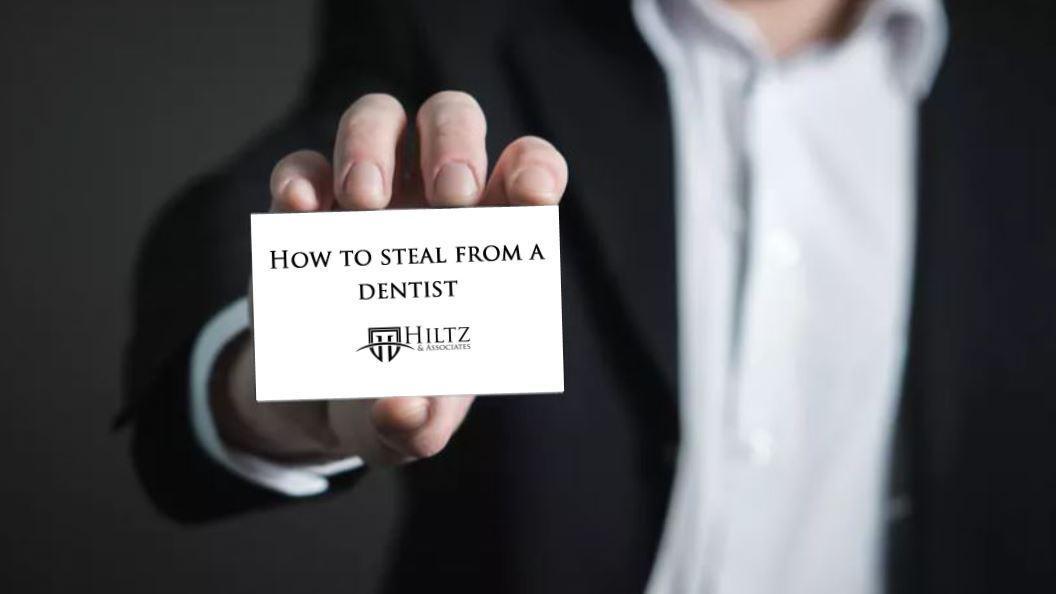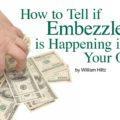#9 • How employees steal from a dental practice.
OUR BLOG HAS MOVED!
This blog was last updated in 2019.
#9 in our series of #TIPS intended to help you manage fraud, embezzlement, waste, abuse; and help keep your practice safe.
This blog-post has been moved to Dental FraudBusters!
Read it here: https://dentalfraudbusters.com/how-employees-steal-from-a-dental-practice/
This post discusses some of the schemes used by employees to steal from a dental practice. These methods are not specific to dentistry, nor do they require cunning skill and intellect to perform.
I have been uncovering these schemes repeatedly in countless practices since 2004, so I feel it is important to remind every dentist beforehand about the most Powerful Fraud Deterrent ever. (you can read about it here)
Also, I should dispel a common myth that is still held by some dentists; paraphrased as “I believe cash is the only thing that employees can steal.”
For those dentists, they believe employees will not steal checks, credit card payments, patient credits, and so on, because these forms of payment are “safe” and cannot be converted into cash.
This is false.
When an employee decides to steal, anything with cash value can be targeted.
 Insurance checks, EFT payments, supplier rebates and refunds to credit cards can all be converted to cash; right in your office.
Insurance checks, EFT payments, supplier rebates and refunds to credit cards can all be converted to cash; right in your office.
Things like electronic devices, dental supplies, and office supplies can be re-sold and converted to cash outside your office.
I recall an office that was handing out $25-$50 pharmacy gift cards to patients who met certain spending criteria. Each month, the two employees at the front desk were handing out thousands of dollars in gift cards, when in fact they were keeping all the gift cards for their own use.
Stealing payments for your work – (the most common)
In the blink of an eye, your money becomes their money.
When an employee steals a payment, depending on the scheme used, it may be straightforward or challenging to detect that money is missing.
Consider what happens when an employee uses dental software to record a payment, produce a receipt, and delete the original payment after the patient has left. The deleted payment does not show up a day end or deposit report. The employee simply pockets the payment.
The employee then may conceal the theft by (#1) deleting the treatment charges and essentially erasing the visit, (#2) applying an adjustment to offset the treatment charges or (#3) back-dating the payment record.
(#1) deleting the treatment charges
A review of the practice software audit log may show details regarding when payments and treatments are deleted, adjustments applied, or payments backdated.
(#2) adjustment treatment charges to conceal theft
When an employee steals a payment, and leaves the treatment on the books, they invariably have to deal with the charges and account balance.
An account adjustment like “courtesy discount” or “insurance adjustment” can be used. Many employees who steal will apply adjustments to offset the payment, and will often choose an adjustment type that is frequently used.
For example, in an office that accepts Blue Cross insurance reimbursement, it may be common to write off the unpaid balance after the insurance payment arrives. (e.g.: a “Blue Cross Adjustment”)
Because the Blue Cross Adjustment is frequently used, it becomes difficult to separate ‘wheat from chaff’ – identifying which of the hundreds of Blue Cross adjustments are legitimate and which ones are fraudulent.
“Write-offs”, “sent to collection”, and other credit adjustment types are used by the employee to create an appearance of balance in the patient’s ledger; all while draining money from the dentist’s treasury.
 Fraud experts agree, the more authority a person has, the more damage they can do. For example, an employee will sometimes use her authority to write off a targeted account as noncollectable.
Fraud experts agree, the more authority a person has, the more damage they can do. For example, an employee will sometimes use her authority to write off a targeted account as noncollectable.
The idea is that once the account is written off, payments on the account are no longer expected. Of course, the patient has no idea that the account has been written off, so the patient continues to make payments on schedule. The employee steals these incoming payments as they arrive and because the account has been “written off”, there is no likelihood it will become delinquent and trigger suspicion.
Instead of writing off accounts as noncollectable, some employees will post an entry to reduce the balance owing. These are often labelled as a “discount” or “professional courtesy.”
For example, an employee intercepts a $100 patient payment and applies a $100 “discount” on the patient’s account to compensate for the missing money. The employee will generally keep the false discounts small enough to avoid review.
#3 – Back-dating is one of the oldest, and still used, schemes.
It works like this:
What really happened: the patient was billed on March 1 and the patient paid on April 20.
The adulterated computer record shows that the patient was billed on March 1 and paid on March 20.
The employee stole the payment made on April 20 and and recorded the payment (back-dated) is as occurring on March 20.
The payment stolen on April 20 will not show on the daily deposit or monthly totals because the payment was recorded as being received in the previous month.
Cash payments are generally stolen on the same day.
Cash is usually stolen the same day treatment is rendered. Patients most often pay by cash at the end of their visit, and therefore detecting missing cash involves a careful examination of each day’s events. Reviewing the audit logs may help. Daily doctor skepticism is advised.
Checks and other forms of payment often arrive after treatment is rendered, and therefore detecting theft requires a careful examination of longitudinal events.
Stealing from insurance companies.
Employees can also steal from insurance companies. The employee generates false a dental claim for a patient of the practice and submits it to the insurance company for reimbursement.
When the insurance check arrives in the mail, the employee converts the check to cash by one of two methods.
Either the check is (i) deposited into the dentist’s bank account and at some time, an equal amount of cash is removed, or (ii) the check is deposited into an account controlled by the employee.
 If the check is made payable to the dentist, the employee can convert the check to cash by depositing the check directly into their own bank account through an ATM.
If the check is made payable to the dentist, the employee can convert the check to cash by depositing the check directly into their own bank account through an ATM.
Sometimes, an employee will collude with a patient (most likely a friend or family member) to steal from the insurance company. The employee sends a fraudulent claim and has the insurance check mailed to the patient. The patient cashes the check and shares the proceeds with the employee.
“Employee perpetrated healthcare fraud is a disturbing trend and requires the employee to use the dentist’s credentials. One of my first cases involved collusion between the employee and a patient. Over $43,000 was paid by an insurance company to the patient for work that was never done. The employee and patient shared the proceeds. Since then, hands-on-experience has shown me that employee perpetrated dental healthcare fraud is prolific.”
William Hiltz BSc MBA CET
Stealing cash from the deposit
In every dental office, someone must physically take the cash and checks to the bank. This person will have an opportunity to take a portion of the money before it is deposited into the dentist’s account.
Separation of function will reduce the risk of deposit tampering. In this example, someone is assigned to prepare the bank deposit slip for the bank and a different employee is assigned to make the physical deposit. The employee who made the deposit keeps a copy of the slip which is matched to a receipted deposit slip issued by the bank when the deposit is made.
Separation of function is designed to prevent deposit tampering but thefts still occur because the process is not adhered to.
In many dental offices, a single person oversees preparing the deposit slips, making the deposit, and reconciling the bank statement. That person can steal money and conceal it by falsifying the deposit slips.
 For example, if the dentist receipts are $1,000 for the day, the employee might fill out a deposit slip for $500 and steal the other $500. The employee will also make corresponding bogus entries to understating the day’s receipts. This process creates a false balance in the dentist’s records. The best way to deter this kind of fraud is to separate the functions of preparing the deposit and making the deposit.
For example, if the dentist receipts are $1,000 for the day, the employee might fill out a deposit slip for $500 and steal the other $500. The employee will also make corresponding bogus entries to understating the day’s receipts. This process creates a false balance in the dentist’s records. The best way to deter this kind of fraud is to separate the functions of preparing the deposit and making the deposit.
Stealing from the dentist’s deposit in this manner will be difficult to conceal for an extended period. Moreover, if separation of function exists, this scheme will only succeed if those responsible for preparing and reconciling the deposit are careless and fail to do their jobs properly.
Yet there are some techniques that employees use to hide deposit tampering which can be successful in the short term. This enables the employee to commit multiple thefts before the crime is discovered.
Deposit lapping is a common method. This occurs when an employee steals Monday’s deposit and replaces it with Tuesday’s deposit. Tuesday is replaced with Wednesday and so on. The thief is always one, two or more days behind and since many dentists do not demand an up-to-the minute reconciliation of their bank statement the fraudster can avoid detection for a period of time.
In order to prevent losses that are concealed by deposit lapping, dentists should require that bank deposits to be made every day. An independent person must verify the dates and amounts of each deposit from the day end summary and cross reference to the bank statement to confirm that the deposit was properly made.



